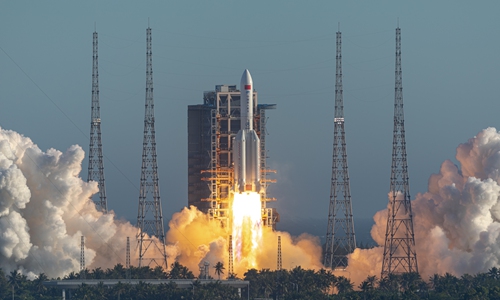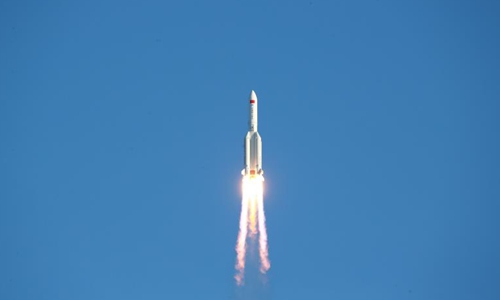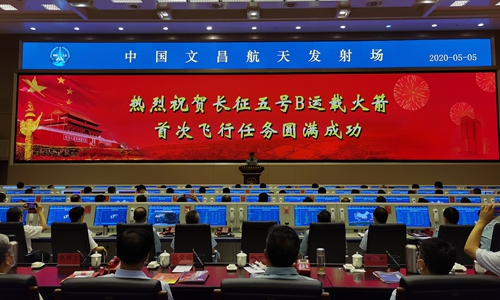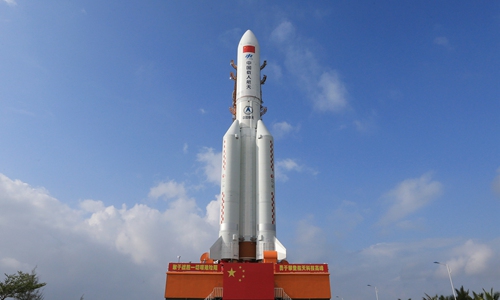China's Long March-5B rocket launched from Wenchang
https://youtu.be/7WFKWs6FhuQ
From Shenzhou-1 to Long March-5B: Tracing China’s space dream
https://youtu.be/XfsWtgQwK-E

https://youtu.be/7WFKWs6FhuQ
From Shenzhou-1 to Long March-5B: Tracing China’s space dream
https://youtu.be/XfsWtgQwK-E
China's new large carrier rocket, the Long March-5B, made its successful maiden flight on Tuesday, marking a new chapter in the construction of China’s space station. Tracing 28 years of China’s space dream -- from the launch of Shenzhou-1 to Long March-5B.

Long March-5B
blasts off from the Wenchang Space Launch Center on the coast of South
China's Hainan Province on Tuesday. Photo: Shi Yue
China's latest state-of-the-art carrier rocket, the Long March-5B, made a successful maiden flight on Tuesday, during which the new rocket managed to send the assembly of a trial version of the country's new-generation manned spaceship with no crew and a testing cargo-returning spacecraft into planned orbit. The successful launch signaled that a new era of the construction of China's manned space projects including space stations has been officially ushered in, according to rocket developer and space industry insiders.
The 53.66-meter-long Long March-5B, with a diameter of 5 meters for its core, took off from the Wenchang Space Launch Center on the coast of South China's Hainan Province on Tuesday. After a flight of 488 seconds, the payloads separated from the rocket's body, and went into designated orbit.
"The successful maiden flight of the Long March-5B, a new type of launch vehicle that has been specially developed for China's manned space projects, marked the era of construction of a Chinese space station officially dawning," Wang Jue, chief commander of the Long March-5B rocket, told the Global Times on Tuesday.
The Central Committee of the Communist Party of China, the State Council [China's cabinet,] and the Central Military Commission extended congratulations on the successful maiden flight of the Long March-5B on Tuesday.
The Long March-5B carrier rocket also made key breakthroughs including achieving a 'zero window launch' - a term to describe extremely high, second-level accuracy of the launch procedure, separation technology between a payload cabin of a large diameter and the rocket body, and high thrust orbiting technology, Li Dong, chief designer of the Long March-5 rocket, told the Global Times.
Such key technological breakthroughs are exclusively relevant to the imminent construction of the space station,, Li explained.
Ji Qiming, an official with China's Manned Space Agency, revealed at a Tuesday press conference that China eyes to complete the construction of its space station by roughly 2022 which includes 12 flight missions.
After the Tuesday debut flight of the Long March-5B, there will be launch missions of the Tianhe core cabin, Wentian and Mengtian lab cabins—which are modules of the space station, Ji said.
There will also be four launch missions each for the Shenzhou manned spaceship and the Tianzhou cargo spaceship, to allow astronauts to rotate time in space and cargo supply.

Photo: Tu Haichao
The Long March-5B carrier rocket with one core stage and four boosters - which is known as a half stage - makes it the first heavy-lift rocket with liquid rocket propellant that has adopted such a one-and-half stage into orbit technology in China, according to a statement from the rocket developer, the China Academy of Launch Vehicle Technology (CALT), of the China Aerospace Science and Technology Corporation (CASC), sent to the Global Times on Tuesday.
Such a one-and-a-half stage mode would remarkably increase the rocket system's reliability as the fewer the stages, the simpler the complexity of the system would be. And the reduced time of stage separation also lowers the chance of malfunctions, per the CALT statement.
The one-and-a-half mode also means better cost efficiency, and such technology has been widely applied in countries like Russia in their space projects with a high rate of success, Song Zhongping, a military and space technology expert, told the Global Times on Sunday.
Pang Zhihao, a Beijing-based space expert, told the Global Times on Tuesday that the maiden flight of the Long March-5B would fill in a blank space in China's carrier rocket category, and declared that China has entered the world's first-class league in terms of large-scale Low-Earth Orbit (LEO) carrier rocket technology capabilities.
The new rocket, using clean fuels such as liquid hydrogen, liquid oxygen and kerosene, weighed 849 tons at launch and has a take-off thrust of around 1,078 tons, enabling it to carry payloads no less than 22 tons into LEO, CALT told the Global Times.
The 22-ton LEO carrying capability of the Long March-5B means that it could send three Tiangong-1 labs into space on one go, Wang Xiaojun, the CALT head, was quoted as saying in the statement.
From the Long March-1's launch capability of 173 kilograms to the Long March-5B's 22 tons, China's space program has set up a much bigger platform for development, Wang said.

Photo: Tu Haichao
Similar in appearance, different in services
The Long March-5B is a smaller variant of the Long March-5, which is currently the strongest member of China's carrier rocket family, and nicknamed by space fans as the "Fat Five" due to its chubby shape. Both rockets belong to the Long March-5 launch vehicle series as they have a similar appearance.
Observers are able to tell the difference between the two brother models of the Long March-5 series by simply looking at the size of their payload fairing and the nose cone on the top of a rocket to protect it against impact pressure and heating during launch through the atmosphere.
Long March-5B possesses the largest payload fairing among all Chinese carrier rockets to date, with a height of 20.5 meters - as tall as a six-story building - and a diameter of 5.2 meters, which, according to the CALT, is customized for the spaceship's launch mission.
Also, the two Long March-5 models vary significantly in the type of services they are supposed to provide. The Long March-5 is mainly used to send large-scale satellites, as well as deep space explorers such as the Chang'e-5 lunar probe and Mars probes, into high Earth orbit, whereas the Long March-5B is the go-to type for launch missions for spacecraft such as the core and lab cabins of the future space station into LEO.
Two more launch missions of the Long March-5 carrier rocket series will be conducted this year. The Long March-5 Y4 will launch the country's first Mars probe by the second half of the year, and the Long March-5 Y5 will send the Chang'e-5 lunar probe to the moon, returning with moon surface samples as the highlight of the mission, according to the CALT.

The ready lineup of 'three warriors'
By the completion of the Long March-5B's maiden flight, all three types of carrier rockets, dubbed the "three warriors" that are commissioned specially for China's manned space projects, are now ready in place.
The three carrier rockets in this series are the Long March-2F, the Long March-7 and the Long March-5B.
Jing Muchun, chief commander of the Long March-2F, told the Global Times that in the past two decades, the Long March-2F has sent five unmanned, six manned spaceships and two space labs into space with a 100 percent success rate.
The 13 successful Long March-2F missions include one sending Yang Liwei, China's first astronaut, into space in 2003.
The Long March-2F has developed two working modes for manned and cargo-only missions, in order to meet the requirements of China's manned space missions.
The Long March-7 is known as the "charted train" for space cargo with a launch capability of 13.5 tons into LEO, and 5.5 tons into 700-kilometer-solar synchronous orbit (SSO.)
"The Long March-7 will be in charge of cargo shipments for the space station, delivering basic material supplies such as water, food and spacesuits for the astronauts. It will also be used to provide necessary material supplies for the space station maintenance as well as conducting in-orbit refueling missions for the space stations," Meng Gang, chief commander of the Long March-7, told the Global Times on Tuesday.
The Long March-2F, the Long March-7 and the Long March-5B carrier rockets will work jointly to build the country's upcoming space station, carrying out launch missions for the space station cabins, spaceship and cargo shuffles respectively, per the CALT statement.
China aims to complete the construction of its space station around 2022. The space station will be a T shape with the Tianhe core module at the center and a lab capsule on each side. The core module - at 16.6 meters long and 4.2 meters in diameter, with a takeoff weight of 22.5 ton - will be the management and control center, the Xinhua News Agency reported.
Source link
RELATED ARTICLES:
- Long March-5B a successful comeback after two failed space launch missions: China’s Manned Space Agency
- Maiden flight of Long March-5B carrier rocket set for 18:00 Tue
Tiangong-2 space lab draws global praise, with the world’s first “cold” atomic clock on board
NASA closely watches Tiangong-2 launch
China's new generation carrier rocket blasts off in Wenchang, Hainan province
China successfully launched Tiangong-2 space lab
China successfully launched their 6th manned spaceflight with Shenzhou 11 to Tiangong-2 space lab
Graphics shows the launching process of Shenzhou-11 manned spacecraft.(Xinhua/Lu ZhChina to send two astronauts to Tiangong-2 space lab tomorrow

China space station will be completed by 2020, the super "eye" to speed up space rendezvous
China's first cargo spacecraft Tianzhou-1 boosts space dream



















